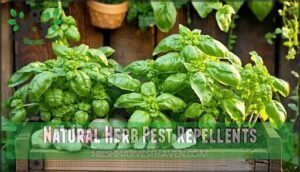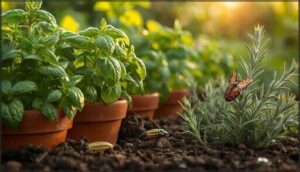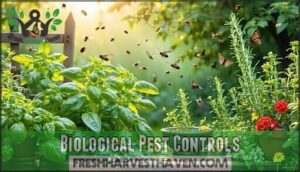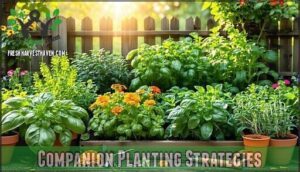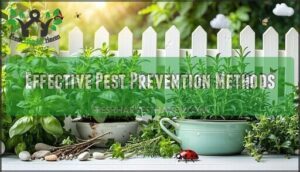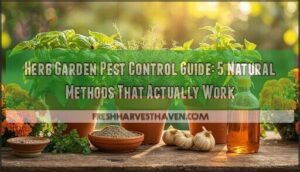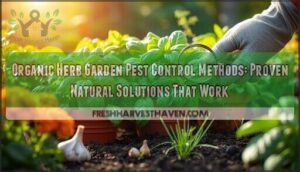This site is supported by our readers. We may earn a commission, at no cost to you, if you purchase through links.
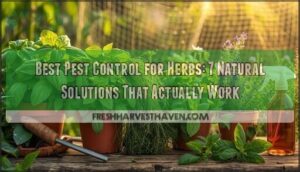
Companion plants like basil, mint, and garlic create protective barriers around vulnerable herbs.
Beneficial insects such as ladybugs and lacewings hunt down aphids and caterpillars that commonly attack herb gardens.
Neem oil spray provides organic protection without harming your harvest.
Daily inspections catch problems early, while proper spacing prevents overcrowding that attracts pests.
Physical barriers like row covers shield tender seedlings from cucumber beetles and other destructive insects.
These methods work because they target pest behavior patterns and life cycles rather than just symptoms, utilizing companion plants and beneficial insects to create a holistic approach to pest control, which is a form of smart prevention.
Table Of Contents
- Key Takeaways
- Natural Herb Pest Repellents
- Common Herb Pests
- Biological Pest Controls
- Companion Planting Strategies
- Effective Pest Prevention Methods
- Frequently Asked Questions (FAQs)
- Are herbs good for pest control?
- What plants are good for pest control?
- Do herbs keep insects away?
- How do herbs repel pests?
- Which herbs attract beneficial insects?
- How to get bugs off of herbs?
- What is the best pest control for basil?
- What flowers and herbs are good for pest control?
- How to control pests on herbs?
- What is safe to spray on herbs?
- Conclusion
Key Takeaways
- You’ll protect your herbs naturally by combining companion planting (like basil with tomatoes) with beneficial insects such as ladybugs and lacewings that hunt down aphids and caterpillars.
- Daily inspections catch pest problems early, while proper plant spacing prevents the humid conditions that attract destructive insects to your herb garden.
- Physical barriers like row covers and copper mesh provide immediate protection against flying pests and crawling threats without using harmful chemicals.
- Neem oil spray offers organic pest control that disrupts insect reproduction cycles while remaining safe for your edible herbs after washing, using beneficial insects and maintaining proper plant spacing.
Natural Herb Pest Repellents
You’ll find that certain herbs naturally repel insects through their chemical compounds, making them excellent companion plants for your garden.
Garlic contains sulfur compounds that deter aphids and beetles, while basil’s aromatic oils keep mosquitoes and flies away from your herb beds, utilizing their natural properties to create a pest-free environment with basil’s aromatic oils.
Garlic
By planting garlic strategically around your herb garden, you’ll create a natural fortress against unwanted pests.
This powerful organic pest control method releases sulfur compounds that effectively deter aphids, mosquitoes, and Japanese beetles without harming beneficial insects.
Here’s how garlic transforms your garden into a pest-free zone:
- Garlic sprays made from crushed cloves provide immediate protection when applied weekly
- Garlic oil penetrates soil, creating long-lasting underground pest deterrent barriers
- Garlic planting near vulnerable herbs establishes permanent insect repelling zones
The garlic benefits extend beyond pest control—this natural pest control champion also strengthens plant immunity through antimicrobial properties, making it essential for successful herb pest control.
Basil
Basil varieties like sweet and Thai basil naturally repel flies, mosquitoes, and aphids through aromatic compounds in their leaves.
You’ll maximize herb pest control by planting basil companion species near vulnerable herbs, creating an organic pest control barrier.
Regular basil propagation guarantees continuous protection while preventing basil diseases that weaken plants’ defensive properties.
Multiple basil uses make this natural pest control method both practical and effective.
Mint
The aromatic mint family delivers powerful natural pest control that’ll transform your herb garden pests management strategy.
Mint varieties like peppermint and spearmint contain concentrated oils that repel ants, mosquitoes, and flies effectively, making them essential for pest control for herbs.
Mint cultivation requires strategic planning since this vigorous grower can overtake neighboring plants.
Mint propagation happens quickly through root division, allowing rapid expansion of your pest defense system.
Maximize mint benefits with these proven techniques:
- Plant containers near vulnerable herbs to prevent aggressive spreading
- Harvest leaves regularly to maintain peak oil concentration levels
- Choose complementary mint varieties for broader pest coverage
- Position strategically around garden perimeters for maximum protection
- Combine with other natural pest control methods for enhanced effectiveness
Mint uses extend beyond pest management—you’ll enjoy fresh leaves for cooking while maintaining effective herb pests control throughout your growing season.
Lemongrass
While mint handles common garden intruders, lemongrass brings serious firepower against mosquitoes through its natural citronella content. This remarkable herb pest control option produces lemongrass oil that creates an invisible barrier around your garden sanctuary.
Climate needs favor warm, sunny locations with consistent moisture. Here’s your propagation methods playbook:
- Choose full-sun spots with well-draining soil for maximum oil production
- Water regularly without creating waterlogged conditions that invite root problems
- Harvest outer stalks frequently to stimulate fresh growth and oil concentration
- Crush leaves near outdoor seating areas for immediate natural pest control activation
Beyond pest control for herbs, lemongrass offers excellent culinary uses in teas and Asian dishes. Your organic pest control strategy gets double rewards. Effective natural pest remedies can also be achieved by combining lemongrass with other methods.
Chrysanthemums
Looking beyond citronella-powered lemongrass, you’ll discover chrysanthemums contain pyrethrum compounds that tackle broader pest challenges in your herb garden.
These flowering powerhouses deliver thorough herbal pest management through natural insect repellents.
Smart gardeners appreciate chrysanthemums’ dual nature—stunning flower arrangements paired with organic pest control.
Their botanical uses extend beyond pest deterrents, making them essential for garden designs.
Proper chrysanthemum care guarantees maximum pyrethrum production while creating beautiful herb pest solutions that actually work.
Common Herb Pests
You’ll encounter four primary pest species that target herb gardens with predictable feeding patterns and seasonal behaviors.
These common invaders include soft-bodied aphids that cluster on new growth, leaf-chewing caterpillars from various moth species, metallic Japanese beetles that skeletonize foliage, and striped cucumber beetles that damage both leaves and stems.
Aphids
While natural repellents provide your first line of defense, aphids present a persistent threat that demands targeted organic pest control strategies.
These tiny sap-suckers reproduce rapidly, with populations doubling weekly under ideal conditions. You’ll notice stunted growth and yellowing leaves as they drain essential nutrients from your herbs.
Aphids multiply fast — your herbs suffer while these pests feast and flourish.
Natural remedies for aphid control include water sprays that remove 70% of populations and insecticidal soaps reducing numbers by 85%. Garden protection involves releasing beneficial insects like ladybugs, which consume up to 50 aphids daily.
Effective organic solutions:
- Your herb garden becomes a battleground when aphids attack
- Watching your prized basil wilt breaks any gardener’s heart
- Sticky honeydew coating leaves feels like nature’s betrayal
- Seeing beneficial insects arrive brings hopeful relief
- Victory over these pests restores your garden’s natural balance
Herbal pest management requires consistent monitoring and rotating treatments to prevent insect repelling herbs from developing resistance to your chosen methods.
Caterpillars
Caterpillars can munch through your herb garden faster than you’d expect. These voracious larvae create distinctive holes and leave dark droppings called frass behind. Caterpillars follow a predictable pest lifecycle, making timing vital for effective caterpillar control.
These leaf-chomping invaders leave telltale holes and dark droppings—catch them early before they devastate your herbs.
| Detection Signs | Control Methods |
|---|---|
| Chewed leaf damage patterns | Hand-pick visible larvae |
| Dark frass droppings | Apply Bt organic sprays |
| Stripped stems overnight | Use diatomaceous earth barrier |
Natural pest control requires consistent monitoring. Organic pest management works best when you catch infestations early. Plant catnip nearby for garden protection – its strong scent deters many caterpillar species naturally.
Japanese Beetles
During summer months, Japanese beetles devour herb foliage with alarming efficiency.
These metallic green pests target soft-leaved herbs like basil and mint, skeletonizing leaves within days.
Beetle traps using pheromones work effectively but position them away from your garden to prevent attracting more beetles.
Organic sprays containing neem oil disrupt their feeding patterns naturally.
Hand-picking during cool morning hours removes up to 85% of visible beetles.
Understanding pest life cycles helps time your beetle control efforts perfectly.
Natural pest control methods protect your herbal pest control program without harmful chemicals.
Cucumber Beetles
Unlike Japanese beetles that feast on foliage, cucumber beetles present a dual threat to your herbs. These striped pests don’t just chew leaves—they spread bacterial wilt that can devastate entire plants. Understanding their beetle life patterns helps you fight back with targeted herbal pest solutions.
These voracious insects emerge in spring, making early cucumber care critical for protection. To manage them effectively, consider the following steps:
- Deploy beetle traps with yellow sticky cards to monitor population levels
- Install row covers during vulnerable seedling stages for physical barriers
- Maintain excellent soil health through compost to strengthen plant defenses
- Use companion planting with radishes as trap crops to redirect beetle attention
Smart natural pest control means staying ahead of these destructive visitors through proven natural insect repellents and strategic pest control for garden management. Effective common pest control methods are essential for protecting herb gardens from damage.
Biological Pest Controls
You can recruit nature’s own pest control team to protect your herbs without harmful chemicals.
These beneficial insects and organic treatments work around the clock to keep damaging pests away from your garden, utilizing beneficial insects to maintain a healthy balance.
Ladybugs
Coccinellidae beetles consume thousands of aphids during their active hunting periods. These beneficial insects target soft-bodied pests with remarkable efficiency throughout their development cycle.
Adult ladybugs patrol herb gardens methodically, while their spiny larvae demonstrate even more aggressive Ladybug Behavior toward pest populations. Their Ladybug Diet includes aphids, spider mites, and scale insects that damage basil, mint, and oregano.
Creating proper Ladybug Habitat involves planting dill, fennel, and yarrow nearby. These flowers provide essential nectar sources that support Ladybug Care requirements.
Ladybug Breeding occurs naturally when conditions support reproduction cycles. You can purchase live specimens online for immediate garden release.
Release purchased ladybugs at dusk when temperatures cool. This timing improves establishment rates in your pest control for garden strategy.
These predators represent effective organic pest control methods that eliminate natural insect repellents needs while maintaining natural pest control balance. For ideal results, consider using Ladybug Products to support your garden’s ecosystem.
Predatory Wasps
Predatory wasps pack a punch in the area of biological control. These tiny pest patrol agents use sophisticated wasp behavior to eliminate herb pests.
Parasitic wasps inject eggs directly into caterpillars and beetle larvae, creating lethal nurseries. You’ll boost wasp attraction by planting dill, fennel, and yarrow near your herbs.
These natural pest control champions need diverse wasps nesting sites with shelter and moisture. They target specific pests without harming beneficial pollinators, making them essential for organic pest control methods in your herb garden.
Lacewings
Lacewing Biology reveals nature’s perfect pest destroyers. Green lacewings target aphids, thrips, and spider mites with surgical precision. Their larvae consume up to 200 aphids weekly, making them superior Natural Predators in your herb garden.
Lacewing Habitat requirements are simple:
- Plant yarrow, dill, and fennel to attract egg-laying adults
- Maintain moisture levels around plants for ideal Biological Controls
- Avoid harsh pesticides that disrupt Beneficial Insects
These organic pest control methods work continuously throughout growing seasons. Effective organic pest control strategies involve creating a balanced ecosystem that fosters the growth of beneficial insects like lacewings.
Praying Mantis
Praying mantis serve as your garden’s apex predators, eliminating threats lacewings can’t handle.
These garden guardians hunt aphids, caterpillars, and beetles with surgical precision.
Their mantis behavior includes patient stalking and lightning-fast strikes that make them perfect insect predators for herbal pest solutions.
You’ll create ideal mantis habitat by planting tall grasses and native shrubs around your herb garden.
These natural insect repellents need shelter for molting and egg-laying.
Position flowering plants nearby to attract their prey, establishing a sustainable ecosystem.
Praying mantis patrol day and night, providing continuous natural pest control.
They’re ambush specialists who wait motionless before striking.
Unlike chemical treatments, these living organic pest control methods adapt to changing pest populations throughout the season, making them invaluable allies for pest control herbs.
Neem Oil
Neem oil stands as nature’s multitasking pest fighter. This organic pest control method contains azadirachtin, which disrupts insect reproduction and feeding patterns.
You’ll eliminate aphids, spider mites, and whiteflies effectively. Mix one tablespoon neem concentrate per gallon of water for ideal neem sprays. Apply during cooler hours to prevent leaf damage.
Neem oil benefits include quick biodegradation and minimal pest resistance development, making it perfect for sustainable herbal pest solutions. For more information on using neem for gardening pest control, consider exploring its various applications.
Companion Planting Strategies
You’ll maximize your herb garden’s natural defenses by pairing compatible plants that work together to repel specific pests.
Strategic companion planting creates a biological shield around your herbs, reducing pest pressure while maintaining healthy growing conditions, which is essential for a thriving herb garden with natural defenses.
Basil and Tomatoes
Beyond biological controls, companion planting offers another powerful strategy.
Pairing basil with tomatoes creates natural pest control that works.
This classic combination repels tomato hornworm larvae and reduces basil pests like aphids through scent masking.
The aromatic compounds in basil varieties deter multiple insects while supporting healthy growth in both plants.
Your herb gardening benefits from this natural pest control method that builds pest resistance.
Garden planning should include these herbal pest solutions since they prevent tomato diseases and create effective pest control methods without chemicals.
By implementing effective companion planting techniques, gardeners can promote a healthier garden ecosystem.
Mint and Tansy
Pairing mint and tansy creates a fortress around your herb garden.
These natural repellents work differently but complement each other perfectly. Mint’s aromatic oils confuse pest navigation systems, while tansy’s bitter compounds make your garden taste terrible to unwanted visitors.
Here’s how this dynamic duo protects your herbs:
- Mint benefits include deterring ants, aphids, and cabbage moths through menthol compounds
- Tansy uses involve repelling cucumber beetles and carrot flies with pyrethroid-like chemicals
- Both plants release stronger scents when brushed, creating active pest deterrents
Plant mint in containers to prevent spreading, while tansy can roam freely in designated areas.
Chives and Lettuce
Chives act as living shields for your lettuce crop, releasing sulfur compounds that naturally deter aphids and other soft-bodied pests.
This companion planting strategy improves both Chive Pests resistance and Lettuce Care while supporting overall Garden Planning.
Natural pest control through companion planting offers these benefits:
- Aphid Control – Sulfur compounds repel harmful insects effectively
- Soil Health – Chives improve nutrient cycling in garden beds
- Herb garden care – Dual-purpose plants maximize space efficiency
- Organic gardening – Chemical-free pest management tips work naturally
Dill and Fennel
Dill benefits extend far beyond the kitchen when you pair it with fennel in your herb garden.
These aromatic allies create a powerful defense system against common garden pests through their natural compounds.
Dill’s carvone and limonene oils effectively repel aphids while attracting beneficial parasitic wasps that hunt down remaining pests.
Keep it away from tomatoes though – dill can actually draw hornworms to those plants.
Fennel uses its trans-anethol compounds to deter slugs and snails that might otherwise feast on your herbs.
Both plants share similar growing needs, preferring full sun and well-draining soil for ideal pest deterrents.
Garden planning becomes simpler when you understand how these herbs work together.
They attract ladybugs and lacewings – nature’s pest control squad that devours aphids naturally.
For herb garden care, position dill and fennel near vulnerable plants.
Their natural insect repellents provide continuous protection while offering culinary rewards.
Fresh dill enhances fish dishes, while fennel adds subtle licorice notes to salads.
Catnip and Garden Protection
Catnip serves as your secret weapon against garden pests, thanks to its potent nepetalactone compound. This powerful herb repels mosquitoes, flies, and cockroaches while creating a protective barrier around vulnerable plants.
You’ll find catnip benefits extend beyond simple pest control—it attracts beneficial predators that hunt harmful insects.
Strategic catnip placement maximizes your garden pest protection:
- Plant near vegetable beds to deter aphids and cucumber beetles naturally
- Create border rows around herbs to stop Japanese beetles from advancing
- Harvest leaves regularly to maintain peak nepetalactone concentration levels
- Space nepeta plants carefully to avoid attracting curious neighborhood cats
- Combine with other herb guardians for thorough organic pest control methods
This natural pest control approach gives you chemical-free herbal pest solutions, making it an ideal choice for those seeking environmentally friendly gardening practices.
Effective Pest Prevention Methods
Prevention works better than treatment when protecting your herb garden from destructive insects. You’ll save time and money by implementing these five simple strategies before pest populations explode.
Daily Inspections
Regular surveillance beats scrambling to fix major infestations later.
Check your herbs every morning, examining both leaf surfaces and stems for pest eggs, larvae, or chew marks.
Daily scouting reveals aphid colonies before they explode and catches caterpillars while they’re still manageable.
Plant examination during peak growing season prevents small problems from becoming garden disasters.
Garden checks take just minutes but save hours of cleanup work.
Proper Plant Spacing
After daily inspections reveal potential problems, proper plant spacing becomes your next line of defense.
Plant density affects air circulation dramatically – herbs crowded together create humid microclimates where pests thrive.
Spatial arrangement with 12-18 inches between plants improves soil quality access and sunlight penetration.
Smart garden layout supports natural pest control by preventing moisture buildup that attracts harmful insects.
Well-spaced herb gardening makes treatments easier to apply and enhances companion planting effectiveness for thorough garden pest management.
Effective organic pest control methods include strategies like integrated pest management to maintain a healthy garden ecosystem.
Crop Rotation
Beyond proper spacing, crop rotation disrupts pest breeding cycles that plague herb gardens year after year.
This sustainable gardening practice prevents soil-dwelling larvae from establishing permanent colonies while promoting soil renewal through crop diversity.
Your rotation schemes should follow these principles:
- Seasonal planning moves susceptible herbs like basil away from previous locations where whiteflies overwintered
- Harvest management alternates heavy feeders with nitrogen-fixing plants to maintain soil fertility
- Natural pest control benefits emerge when you rotate mint family herbs with alliums, breaking aphid reproduction cycles
Smart rotations keep pests guessing while your soil stays healthy.
Physical Barriers
Physical barriers act like bodyguards for your herbs, creating impenetrable shields against unwanted invaders. Row covers allow 95% light transmission while blocking flying pests completely. Copper mesh delivers mild electrical charges that repel slugs and snails on contact. Fine nets prevent aphid infestations before they start.
| Barrier Type | Target Pests |
|---|---|
| Row Covers | Moths, beetles |
| Copper Mesh | Slugs, snails |
| Fine Nets | Aphids, thrips |
| Plant Screens | Caterpillars, flies |
Fence barriers protect against larger mammals like rabbits and deer. These physical deterrents require no chemicals and work immediately upon installation. Position barriers during peak pest seasons for maximum effectiveness in your natural herb pest control system. Using row cover products can enhance the overall protection of your herbs against pests.
Healthy Soil Maintenance
Strong soil creates natural herb defenses against pests.
Soil testing reveals nutrient gaps, while compost usage and organic fertilizers build healthy microbial communities.
Maintain pH balancing between 6.0-7.0 for ideal nutrient uptake.
Apply mulch benefits to retain moisture and suppress weeds.
Rich soil enrichment supports biodiversity that deters harmful insects naturally.
Frequently Asked Questions (FAQs)
Are herbs good for pest control?
Yes, herbs work effectively for pest control.
Many contain natural oils that repel mosquitoes, flies, ants, and other insects.
You’ll get chemical-free protection while enjoying culinary benefits from plants like basil, lavender, and rosemary.
What plants are good for pest control?
Studies show 20-40% of crops fall to pests annually.
You’ll find lavender, basil, and marigolds excel at repelling mosquitoes and aphids naturally.
Rosemary deters cabbage moths while chrysanthemums pack pyrethrum compounds against various insects.
Do herbs keep insects away?
Aromatic herbs like basil, rosemary, and mint naturally repel mosquitoes, flies, and ants through their essential oils.
You’ll find these fragrant plants create protective barriers around your garden while doubling as culinary ingredients, which also makes them useful for culinary ingredients.
How do herbs repel pests?
Like tiny chemical factories, herbs produce volatile compounds that act as nature’s "keep out" signs.
Essential oils in their leaves release scents that confuse insects’ sensory receptors, disrupting their ability to locate food sources and navigate effectively, acting as a form of natural defense with volatile compounds.
Which herbs attract beneficial insects?
Several herbs work double duty by attracting beneficial insects while repelling pests.
You’ll find dill draws ladybugs and parasitic wasps that devour aphids.
Tansy brings in helpful predators while deterring ants.
Cosmos invite lacewings that feast on garden troublemakers, which can be considered a beneficial aspect of gardening.
How to get bugs off of herbs?
Use water spray to knock off aphids and whiteflies. Apply insecticidal soap or neem oil for tougher pests. Hand-pick larger insects like caterpillars. Diatomaceous earth creates barriers against crawling bugs.
What is the best pest control for basil?
Plants guard themselves with chemical warfare just like your grandmother’s herb garden.
You’ll protect basil best using companion planting with marigolds, regular water sprays, and organic neem oil treatments to control aphids and whiteflies naturally.
What flowers and herbs are good for pest control?
Marigolds, chrysanthemums, and petunias effectively repel various insects. Herbs like basil, lavender, rosemary, and mint deter mosquitoes and flies. You’ll create natural barriers that protect your garden without harsh chemicals.
How to control pests on herbs?
Combine water sprays with insecticidal soap to knock off aphids and whiteflies.
Plant companion herbs like basil and rosemary nearby.
Monitor daily, prune damaged parts, and use neem oil when needed.
What is safe to spray on herbs?
You can safely spray insecticidal soap, neem oil, or garlic-based solutions on your herbs. These organic options effectively control aphids and other pests while remaining safe for consumption after washing.
Conclusion
Before smartphones made plant identification instant, gardeners relied on field guides and decades of experience to spot pest problems.
You’ve learned the best pest control for herbs requires patience and observation. These natural solutions work because they target specific pest behaviors and life cycles.
Daily inspections help you catch aphid colonies before they explode. Companion planting creates protective zones around vulnerable herbs.
Beneficial insects provide ongoing pest management without chemicals. Physical barriers stop cucumber beetles during critical growth periods.
Success comes from combining multiple strategies rather than relying on single solutions, using methods like companion planting and physical barriers to ensure ongoing pest management.

